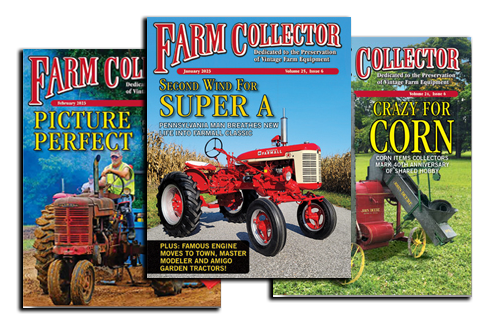Le Roi engines were first made in 1913, mainly for farm
tractors. The earliest smaller engine I have seen is the Model 2-C
dated 1919. The company made many different models with 1, 2 and 4
cylinders.
Around 1930, Le Roi started making engines with ball bearings on
the main bearings and camshaft; these were all L-head engines. I
have an original sales brochure from the early 1930s stating 87
percent of the internal parts of these engines interchange. In all
of the engines I have disassembled, there is only one connecting
rod, valve, and spring and piston size – 3-1/8-inch for all of the
Model M and derivatives. The ball bearing engines are mostly
2-3/4-inch bore and they have the bearing made into the rod instead
of an insert; they also have a smaller diameter valve.
Remember that these engines were primarily designed as power
units. There were several models that used the same parts but
changed the drive train, such as clutches, in-and-out boxes,
transmissions, etc. There were many different flywheels, depending
on the application. Some of the Model Ms had the power direct off
of the crankshaft and some off of the camshaft for a gear
reduction. They made the camshaft about 4 inches longer and added a
ball bearing to help carry the load. If the engine was designed for
a light-duty application, it had only one set of gears. For a heavy
load, they doubled the camshaft gears.
Prior to 1940, the first overhead valve engine, the Model D-140,
was developed. One of my books shows a spark plug change in 1940.
They continued to make several different Model D engines and all of
these engines are virtually identical to Allis-Chalmers engines. I
have always been told that Westinghouse Air Brake Co., owned by
Dresser Industries (who also owned Waukesha), bought Le Roi in 1954
and production was moved to Clinton, Iowa, to Climax Engine Co. The
engines were called Le Roi Roiline. The Dresser engine website
states Waukesha bought Climax in 1957.
Recently, I obtained a small booklet dated 1950 calling the
engines “Le Roi Roiline” so obviously the buyout was earlier than
1957. Somewhere around 1958, all Le Roi production ceased and
supposedly all company records were destroyed.
I called the Clinton historical society to see if they had
anything on the engine factory or Le Roi engines. I was informed
the Climax engine factory was closed down in the early 1980s and
the historical society was presented with about eight large boxes
of old company records. Evidently, no one had expressed an interest
in them until now. The historical society is now going through
trying to get an estimate of what is in the boxes. This may be a
treasure and may answer questions about several brands of
engines.
They also sent me a copy of a page from the book The Way Things
Were, which is a historical perspective of the area and has an
article from the newspaper when the plant shut down. Apparently,
Climax developed the large engines that Le Roi made primarily for
the oil fields. The largest engine Le Roi made is a 3,006-cubic
inch, 400 HP V-12. The cylinders were made in pairs. They made 4-,
6- and 8-cylinder engines all using the same cylinders. There are
still many V-12s running cotton gins today.
Le Roi also had the Centaur tractor that turned into the
TractAir, which had a 4-cylinder engine and 2-cylinder air
compressor on the tractor. Those were made for many years. I am
always looking for more information to help people out. I now have
15 Le Roi engines, each one a different model.
Contact Ed Malcom, “The Le Roi Man” at: 39 Malcom Lane,
Pineville, MO 64856; (479) 903-3005; (417) 226-4865 (evenings);
momalco@olemac.net











